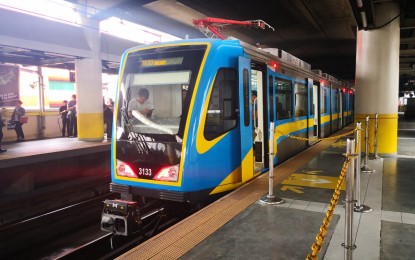
A Dalian train at an MRT-3 station. (Photo courtesy of DOTr)
MANILA – An official of the Department of Transportation (DOTr) on Tuesday clarified that the Dalian trains purchased during former president Benigno “Noynoy” Aquino III’s administration are undergoing repair and have made little impact on the Metro Rail Transit Line 3’s (MRT-3) improved service.
In a Facebook post, DOTr Assistant Secretary Goddes Hope Libiran said only three Dalian train sets have so far been modified and accepted into the MRT-3 fleet, noting that these trains require validation and testing to ensure their safety.
“In the last three months, walang tumatakbong Dalian train dahil lahat ay for repair and tests (there have been no Dalian trains running as all were undergoing repair and testing),” Libiran said.
This came after President Rodrigo Roa Duterte commended the DOTr and the MRT-3 management during his final State of the Nation Address (SONA) on Monday, noting the rail service’s transformation from being a “horror for daily commuters”.
"MRT-3, with its frequent breakdowns and unloading of passengers mid-rail-- that was a horror for the daily commuters to endure in the past. Now, MRT-3 no longer unloads passengers, but to their destinations," Duterte said.
He said the MRT-3, which had 10 running trains at only 30 kilometers (km) per hour (kph) in 2016, now operates a maximum of 23 running trains at 60 kph.
The MRT-3 said all of its 72 train cars have also been equipped with “new and regularly-maintained” air-conditioning units, while all of its 46 elevators and 34 escalators are “fully functional”.
“MRT-3 has also already completed its CCTV and platform monitors rehabilitation, with 292 new and high-resolution CCTV units and 30 platform monitors installed in all its 13 stations,” it added.
It said the rail line’s “massive rehabilitation” is slated to be completed in December, in time for a possible “return to normalcy,” as the pandemic reduced passenger capacity in public transportation. (PNA)
